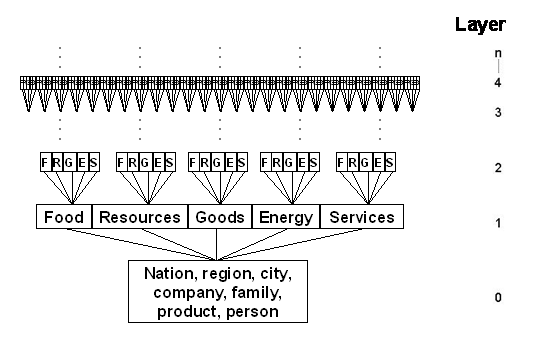 |
Integrated Sustainability Analysis |
 |
| Home Contact Search Media |
Ecological Footprints without boundariesIn conventional Ecological Footprints, the land areas included are mainly those directly required by households, and those required by the producers of consumer items. These producers, however, draw on numerous input items themselves, and the producers of these inputs also require land. Generally speaking, in modern economies all industry sectors are dependent on all other sectors, and this process of industrial interdependence proceeds infinitely in an upstream direction, through the whole life cycle of all products, like the branches of an infinite tree. Such a production "tree" is shown schematically in Fig. 1: the population to be examined represents the lowest level, or production layer zero. The land required directly by the population (for example land occupied by the house, land required to absorb emissions caused in the household, or by driving a private car) is called the direct land requirement. All other, indirect land requirements originate from this layer. The providers of goods and services purchased by the population form the production layer number one, and their land requirements are called first-order requirements. The suppliers of these providers are production layer number two, and so on. The sum of direct and all indirect requirements, is called total requirements. A specific example for direct and indirect requirements in the ecological footprint of a family is shown in Fig. 2. Direct requirements in production layer zero are represented by the land required for the familys home and for absorbing the emissions caused by the burning of petrol, natural gas and other fuels in the household and the car. One item contributing to the familys ecological footprint could be a train journey. The family does not directly require land by using this train. However, the train uses diesel fuel, which causes the emission of greenhouse gases. The rail transport operator providing this service is part of production layer 1, and the land required to absorb these emissions is an example for a first-order indirect requirement. Furthermore, the train itself needed to be built, and the land occupied by the train manufacturer (part of layer 2) is a second-order requirement. Land and emissions associated with the steel plant producing the steel sheet (layer 3) for the train are third-order requiremerequirements, the land mined to extract the iron ore (layer 4) for making the steel sheet is a fourth-order requirement, and so on. Each stage in this infinite supply process involves land use and emissions. The supply chain iron ore for steel sheet for passenger train for train journey for family (highlighted in red in Fig. 2) is called a structural path of fourth order. Since the production tree is ever-expanding in an upstream direction, the number of structural paths increases towards layers of higher order. On the other hand, higher-order paths also become less and less important, because at each stage only a part of the supplier's direct ecological footprint is "passed on" to the recipient. Nevertheless, Figs. 1 and 2 demonstrate that calculations that consider only layers zero and one underestimate the true ecological footprint. Even though indirect requirements, production layers and structural paths can be very complex, there exists a method for their calculation: input-output analysis. This is a macroeconomic technique that relies on data on inter-industrial monetary transactions, as documented for example in the Australian input-output tables compiled by the Australian Bureau of Statistics. Since its introduction by Nobel-prize laureate Wassily Leontief, input-output analysis has been applied to numerous economic, social and environmental issues. It was first applied by Bicknell and co-workers in 1998 to calculate an ecological footprint for New Zealand. Another advantage of using input-output analysis is that imports and exports can be accounted for. For example, a population with an ecological remainder could use that remaining land unsustainably for producing exports, and therefore in reality not have any remaining ecological capacity. Also, an ecological deficit of a population may be due to imports of consumer items from countries practicing unsustainable production methods, with the environmental impacts occurring outside its borders, and the local ecosystems well preserved. In addition, input-output analysis draws on detailed data sets which are regularly collected by government statistical agencies, such as input-output tables and household expenditure surveys. Using Australian data, input-output-based ecological footprints can be calculated for more than 100 industry sectors and product groups, for states, local areas and cities, and for companies and households. Since 1998, many teams around the world, such as in Australia, New Zealand, the UK, Italy and Taiwan, have moved to input-output-based Ecological Footprints. For further information please contact
|

